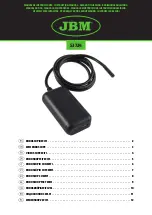
Form V372, Rev. 12
- 10 -
12/18, ECN4334
SECTION 5: NORMAL OPERATION
Operation of the Rotamix
TM
system involves operation of the Vaughan pump(s). The objective in
Rotamix
TM
operation is achieving effective mixing in your storage tank or digester. This may or may not
require operation of the Rotamix
TM
system on a 100% duty cycle. Many times this system may be
operated on a timer, on a duty cycle less than 100%. As a general rule, a Rotamix system requires 30-
60 minutes to reach steady state mixing, and it may require several days of mixing after that to achieve
a homogeneous slurry in the tank. Note however, that if the Rotamix
TM
system is operated
intermittently, there may be more of a challenge in properly venting the pump of gas prior to each pump
startup, and so an automatic venting system should be considered during design. This gas venting
issue is discussed above in the Installation section.
Digester Mixing:
Vaughan Co. as well as most consulting engineering firms have concluded in recent years that the use
of a variable frequency drive (VFD), also called a variable speed drive (VSD), is the best method for
mixing a digester. The VFD provides a way to cut power usage significantly, often cutting power
expenses in half over time, while also providing a way to continue low speed mixing during foaming or
rapid volume expansion events.
Mixing during foaming or rapid volume expansion (RVE):
Intermittent mixing (that is, turning the mixing pump on and off over various periods of time) leaves
pockets of undigested feed sludge in the digester to suddenly erupt in gas generation as soon as
mixing is restarted. Because of this effect, intermittent mixing can exacerbate both foaming or rapid
volume expansion problems. The better approach has proven to be the use of the VFD controller to
maintain continuous mixing while reducing mixing pump speed when necessary. During foaming or
RVE disruptions mixing can (and should) continue at lower mixing pump speeds, typically at about 75%
of full speed, which is about 42% of full power. Mixing pump speeds below about 75% of full speed is
not recommended because very low speed operation risks plugging nozzles as pump pressure falls off
rapidly. The value of maintaining continuous mixing during foaming or RVE events is that pockets of
feed sludge are continuously mixed with the rest of the digestate, spreading out gas generation over a
maximum time period to minimize sudden bursts of liberated gas. By maintaining continuous mixing at
lower speeds, the gas generation and therefore the foam generation, is kept more under control.
Reduced energy mixing for power savings:
Many mixing systems tend to be slightly overdesigned to allow for variations in sludge concentrations
and viscosities and to pass the startup mixing tests. However, many Rotamix systems can be operated
quite effectively for about 22 hours/day at 75% of full speed and for 2 hours/day at 100% if full speed,
resulting in savings of about 50% of the full-speed electrical costs. Consult with Vaughan Co. as to
whether your mixing system can be used in this way.
Intermittent Rotamix system operation:
Vaughan Co. recommends against the use of intermittent Rotamix system operation of digester mixing
because of the problems of controlling foaming or RVE events. However, some users for various
reasons opt not to use a VFD controller for mixing pump speed control and instead opt to use
intermittent mixing. Intermittent mixing works best in digesters where foaming does not occur.
Experience has shown that the majority of gas generation in a digester occurs while new sludge is
being added, and so the Rotamix system should be run during this time. Therefore, if intermittent
mixing is going to be used, the Rotamix system should be started about 60 minutes before adding new
sludge and should be shut down about 60 minutes after stopping the addition of new sludge. This mode
of operation generally amounts to about a 35% to 50% duty cycle and saves a considerable amount of
electricity. Vaughan Co. encourages experimentation so that you get the best possible mixing using the
lowest possible energy requirements for your system. Generally, the mixing system should be run for at
least 3
–4 hours at a time, then perhaps the pump can be shut off for an equal amount of time, say 4
hours on, 4 hours off. Operation of the mixing system for short periods of time, such as less than 60
minutes will not provide any useful mixing. Again, most tanks must be run for 30
–60 minutes just to
reach full mixing velocity in the tank; active digester mixing occurs
only
after reaching full mixing
velocity.





































